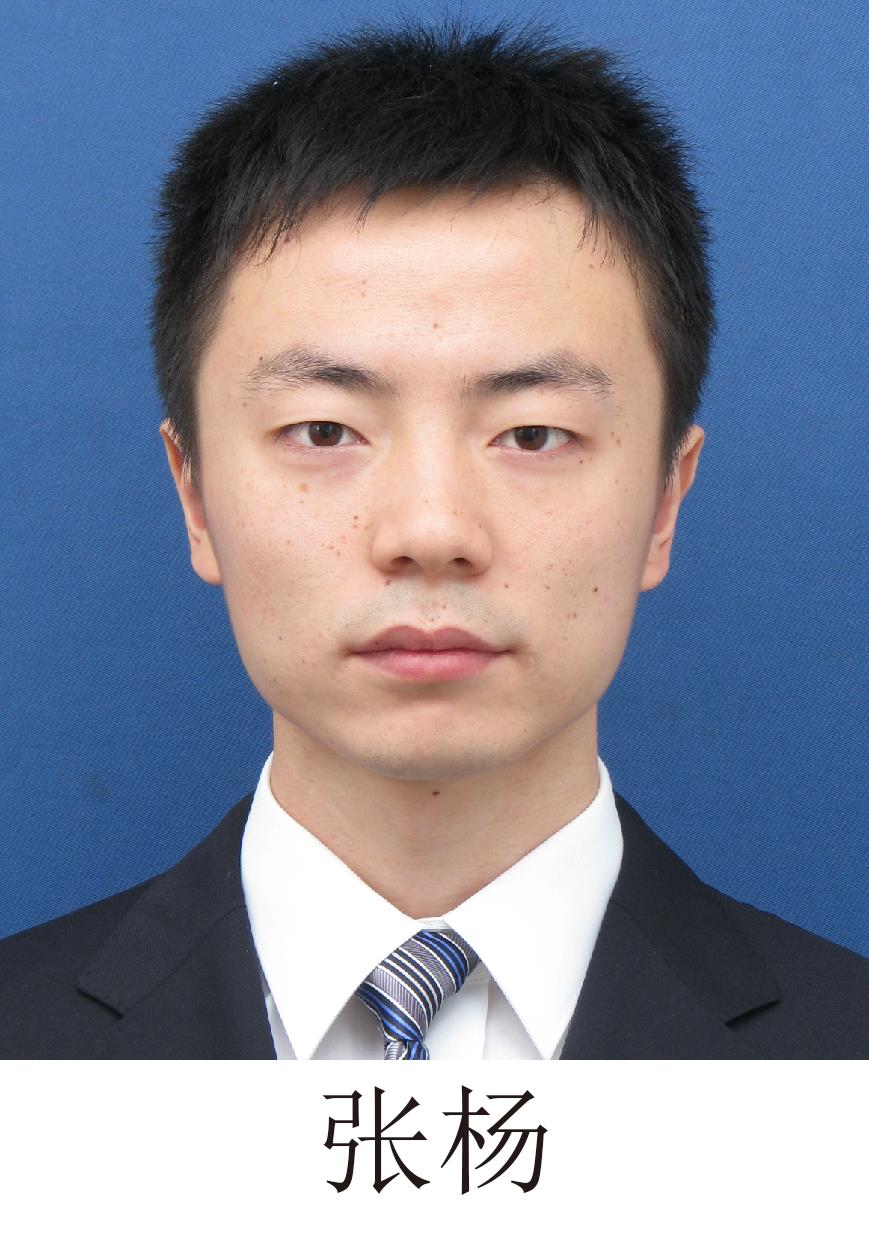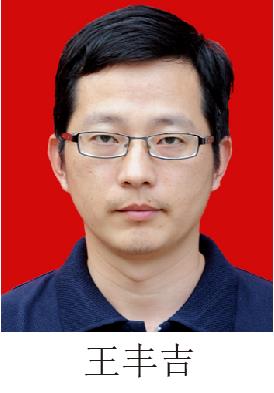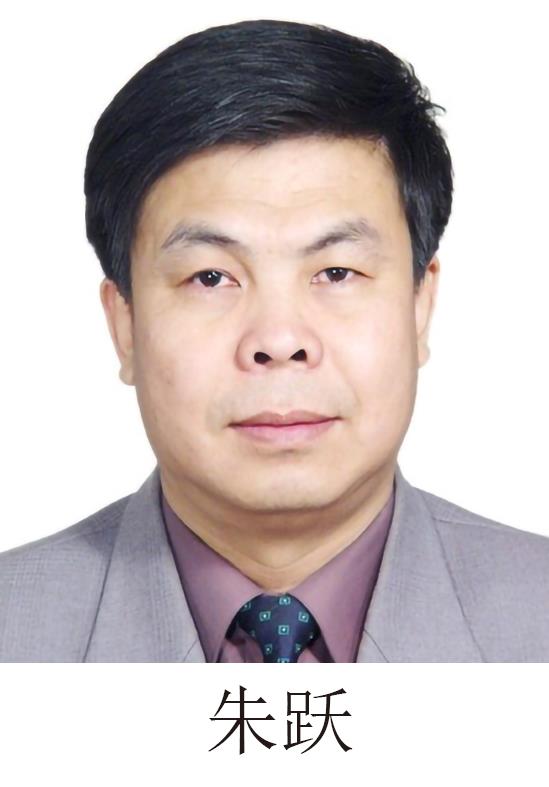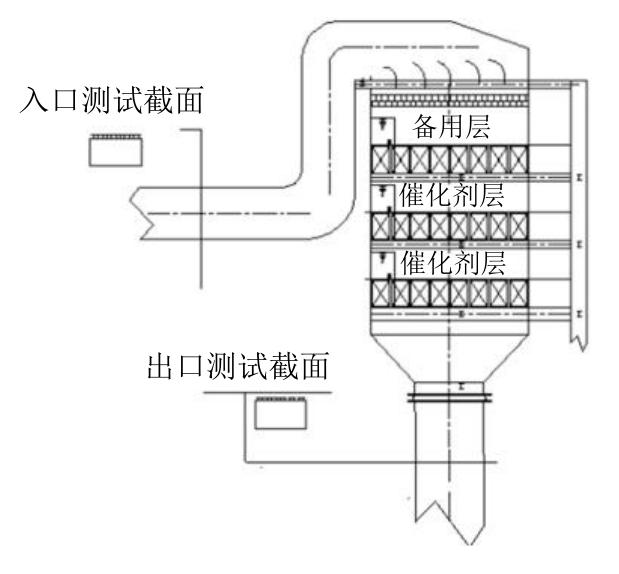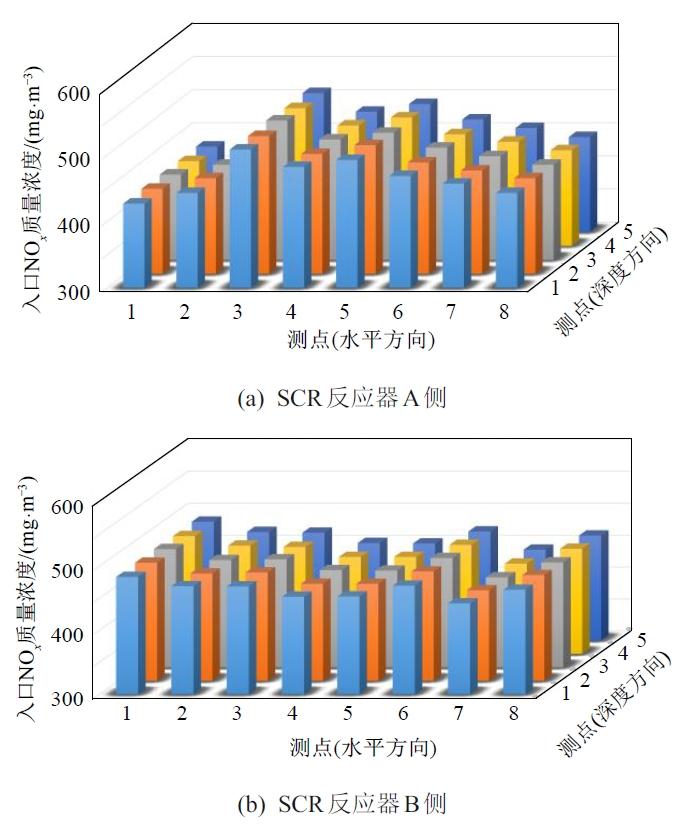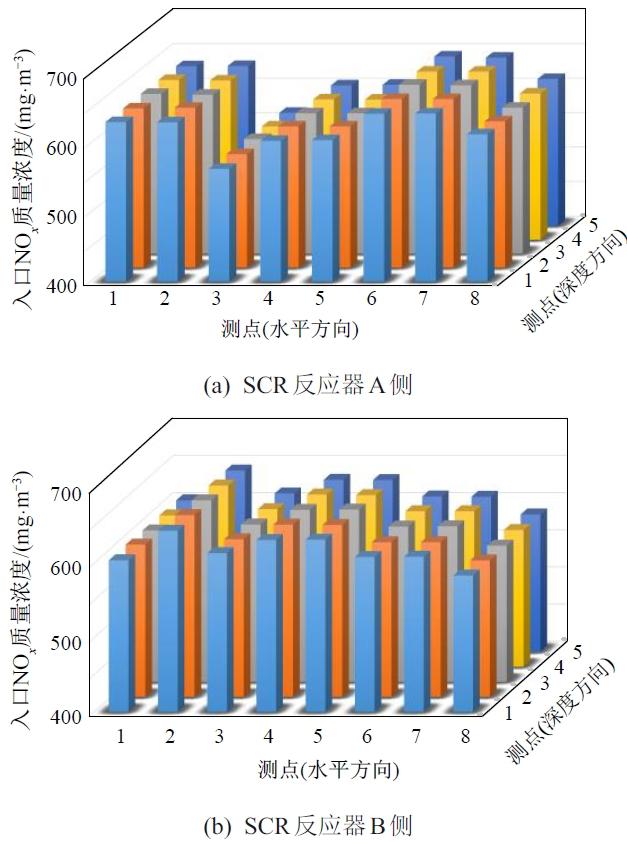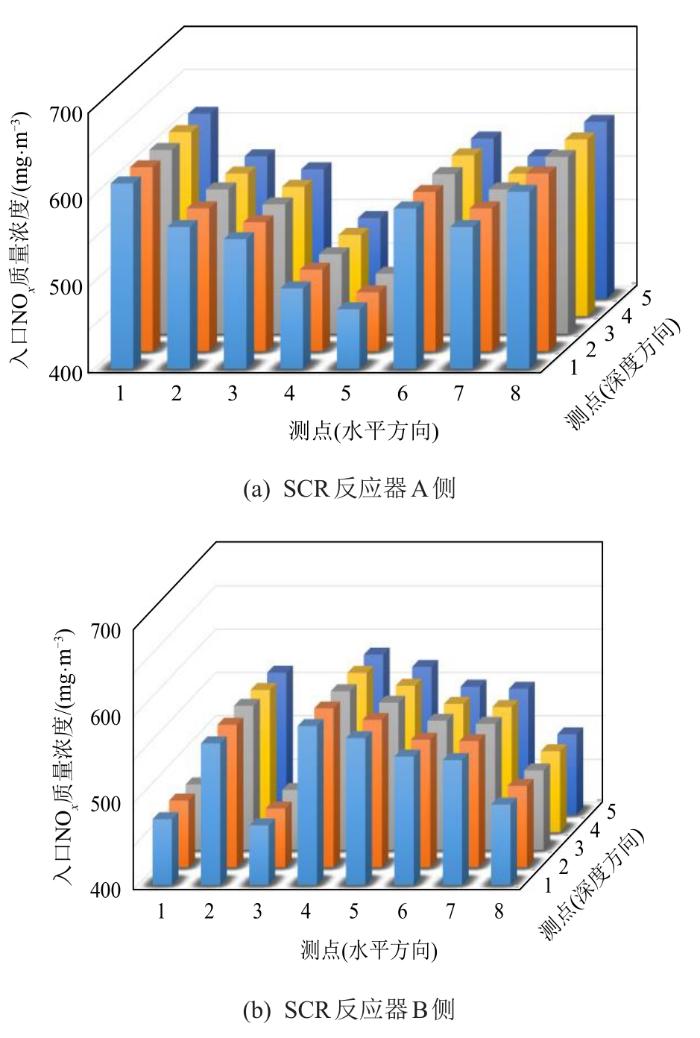0 引言
为响应三部委提出的《煤电节能减排升级与改造行动计划》(2014—2020年)[1],国内燃煤电厂纷纷开展超低排放改造工作[2-5]。选择性催化还原(selective catalytic reduction,SCR)作为我国燃煤电厂烟气脱硝主流工艺,在本次脱硝超低排放改造技术中仍占据绝对主导地位[6-8]。超低排放改造后更低的排放限值势必会对运行调控的要求更高,同时氨逃逸引起的下游装置(如空预器)硫酸氢铵堵塞和催化剂失活等问题也将越发突出,对机组安全稳定运行造成不利影响。而1 000 MW燃煤机组作为国内先进机组排头兵,对其脱硝装置超低排放改造后的关键参数进行性能评估与分析,有利于掌握此类机组脱硝装置实际性能,同时通过评估分析其超低排放改造后暴露的问题,也有助于剖析问题产生的根源。
为此,以已实现脱硝超低排放的某1 000 MW燃煤机组SCR脱硝装置为例,对该脱硝装置不同负荷工况下的关键运行参数进行分析研究,针对存在的问题,提出相应的解决措施,以期为燃煤机组超低排放新形势下实际运行调整提供指导和借鉴。
1 脱硝装置概况
表1 某1 000 MW燃煤机组脱硝系统主要设计参数
Tab. 1
| 设计参数 | 数值 |
|---|---|
| 机组容量/MW | 1 000 |
| 脱硝装置入口NO x 质量浓度/(mg·m-3) | 400 |
| 脱硝装置出口NO x 质量浓度/(mg·m-3) | ≤50 |
| 脱硝效率/% | ≥87.5 |
| 氨逃逸质量浓度/(mg·m-3) | ≤2.28 |
| 飞灰质量浓度/(g·m-3) | 50 |
| 脱硝装置单反应器入口烟道截面/(m×m) | 4.6×14.804 |
图1
图1
脱硝装置性能试验测试位置
Fig. 1
Test positions for performance test of denitrification unit
2 性能试验评估及分析
2.1 脱硝效率
表2 入口、出口NO x 质量浓度及其脱硝效率测试结果
Tab. 2
| 参数 | 负荷工况 | 原设计值 | ||
|---|---|---|---|---|
| 高 | 中 | 低 | ||
| A侧入口NO x 质量浓度/(mg·m-3) | 401 | 602 | 589 | 400 |
| B侧入口NO x 质量浓度/(mg·m-3) | 377 | 590 | 551 | 400 |
| A侧出口NO x 质量浓度/(mg·m-3) | 40 | 39 | 50 | 50 |
| B侧出口NO x 质量浓度/(mg·m-3) | 43 | 36 | 43 | 50 |
| A侧脱硝效率/% | 89.99 | 93.50 | 91.57 | 87.50 |
| B侧脱硝效率/% | 88.63 | 93.92 | 92.24 | 87.50 |
| 平均脱硝效率/% | 89.32 | 93.71 | 91.89 | 87.50 |
2.2 SCR入口NO x 浓度分布
图2
图2
高负荷工况下SCR入口NO x 质量浓度分布
Fig. 2
NO x concentration distribution at inlet of SCR under high load condition
表3 SCR入口NO x 质量浓度分布相对标准偏差
Tab. 3
| 位置 | 相对标准偏差/% | ||
|---|---|---|---|
| 高负荷 | 中负荷 | 低负荷 | |
| A侧 | 3.5 | 2.5 | 5.4 |
| B侧 | 1.7 | 1.8 | 5.0 |
图3
图3
中负荷工况下SCR入口NO x 质量浓度分布
Fig. 3
NO x concentration distribution at inlet of SCR under medium load condition
图4
图4
低负荷工况下SCR入口NO x 质量浓度分布
Fig. 4
NO x concentration distribution at inlet of SCR under low load condition
2.3 SCR出口NO x 浓度分布
高、中、低负荷工况下SCR出口NO x 质量浓度分布分别如图5—7所示,SCR出口NO x 质量浓度分布相对标准偏差如表4所示。与SCR入口NO x 质量浓度分布情况相反,由图5—7及表4可见,不同负荷工况下SCR出口NO x 质量浓度分布变化情况各不相同,其中:高负荷工况下不均匀程度最高,SCR出口A、B两侧的NO x 质量浓度分布相对标准偏差都在50%以上;中负荷工况次之,其NO x 质量浓度分布相对标准偏差都在30%以上,但同时该工况下A、B两侧之间的相对标准偏差最大,达到30.5%;低负荷工况下偏差相对而言最小,但是其A、B两侧之间的相对标准偏差也达到了22.6%。这些结果表明脱硝装置出口NO x 质量浓度分布很不均匀,分析其原因,一方面是超低排放后排放值更低,对运行调控要求更高,调整难度更大,容易造成喷氨不均;另一方面则是前期超低排放改造过程中未有效开展脱硝装置流场改造或改造措施有限。为此,需要提高认识,提升运行调控水平,加强喷氨优化调整,必要时根据机组自身实际情况开展精准喷氨或智能喷氨改造工作[13-16]。
图5
图5
高负荷工况SCR出口NO x 质量浓度分布
Fig. 5
NO x concentration distribution at outlet of SCR under high load condition
图6
图6
中负荷工况SCR出口NO x 质量浓度分布
Fig. 6
NO x concentration distribution at outlet of SCR under medium load condition
图7
图7
低负荷工况SCR出口NO x 质量浓度分布
Fig. 7
NO x concentration distribution at outlet of SCR under low load condition
表4 SCR出口NO x 质量浓度分布相对标准偏差
Tab. 4
| 位置 | 相对标准偏差/% | ||
|---|---|---|---|
| 高负荷 | 中负荷 | 低负荷 | |
| A侧 | 62.2 | 69.0 | 57.6 |
| B侧 | 52.2 | 38.5 | 35.0 |
2.4 氨逃逸
SCR反应器出口氨逃逸浓度如表5所示,可以看出,在高负荷和中负荷工况下,SCR反应器出口A、B两侧NH3质量浓度均超出脱硝装置原设计值(2.28 mg/m3)。结合上述分析可以看出,脱硝效率要求越高、浓度场均匀性越差时,氨逃逸浓度超标情况越明显。这主要是因为机组调峰引起的负荷多变导致NO x 浓度波动大,同时超低排放改造后对流场均匀性更高的要求也容易引起氨逃逸浓度超标,此外,氨逃逸浓度在线表计监测不准、催化剂寿命管理不合理等问题也会给氨逃逸控制增加难度。为此,一方面要注意加强低氮燃烧优化调整工作,另一方面定期开展喷氨优化试验[17-18]工作仍十分必要,同时还应关注催化剂全寿命管理[19],定期对运行中催化剂检测进行评估[20-21]。
表5 SCR反应器出口氨逃逸浓度 (mg·m-3)
Tab. 5
| 条件 | A侧出口 | B侧出口 | ||
|---|---|---|---|---|
NH3质量 浓度 | NH3质量 浓度平均值 | NH3质量 浓度 | NH3质量 浓度平均值 | |
| 高负荷 | 2.54 | 4.73 | 2.83 | 3.16 |
| 3.86 | 3.47 | |||
| 7.81 | 3.17 | |||
| 中负荷 | 3.23 | 4.21 | 2.42 | 3.05 |
| 3.31 | 3.30 | |||
| 6.09 | 3.44 | |||
3 结论
通过对已完成超低排放改造的某1 000 MW燃煤机组开展SCR脱硝装置性能测试,分析研究了该脱硝装置不同负荷工况下的脱硝效率,入口、出口NO x 浓度分布,以及氨逃逸浓度等关键运行参数,试验结果表明:该机组SCR脱硝装置整体性能良好,但流场均匀性差、氨逃逸浓度超标等问题仍然存在。针对这些问题,相应的解决措施主要有:
1)运行人员应加强锅炉燃烧调控水平,优化锅炉运行及低氮燃烧调整,将氮氧化物生成浓度控制在原设计值以下水平,必要时可以考虑低氮燃烧优化改造或SNCR-SCR联用工艺。
2)优化氨喷射系统,定期或不定期开展喷氨优化及流场均匀性试验,对脱硝装置开展现场冷态流场摸底试验与数值模拟相结合工作,必要时根据机组自身实际情况开展精准喷氨或智能喷氨改造工作。
3)重视催化剂全寿命管理工作,定期对运行中催化剂进行检测评估。
4)加强脱硝设备及仪表维护力度,提高运行维护管理水平。
参考文献
关于印发《煤电节能减排升级与改造行动计划(2014—2020年)》的通知(发改能源
[2014]2093号)[EB/OL].(
JB5
.
Notice on printing and distributing “The Action Plan for Energy Saving, Emission Reduction, Upgrade and Transformation of Coal Power
(2014-2020)” ([2014]
1 000 MW 燃煤发电机组碱渣脱硫试验研究
[J].
Experimental investigation on alkaline residue desulfurization of a 1 000 MW coal-fired electricity generation unit
[J].
基于解决地区大气污染的能源消费革命研究
[J].
Research on energy consumption revolution based on solving regional air pollution
[J].
燃煤电厂超低排放湿法脱硫治霾影响分析
[J].
Influence analysis on haze control of ultra-low emission wet flue gas desulfurization of coal-fired power plants
[J].
燃煤电厂超低排放系统能耗关键因素分析
[J].
Study on key factors influencing energy consumption of ultra-low emission system in coal-fired power plant
[J].
现役燃煤机组SCR烟气脱硝装置运行现状分析
[J].
Analysis on operating status of SCR facilities in active coal-fired units
[J].
燃煤烟气中Hg 迁移转化特性研究
[J].
Hg formation and transformation characteristics in flue gas of coal-fired boiler
[J].
300 MW级燃煤机组SCR烟气脱硝超低排放性能评估
[J].
Evaluation on ultra-low emission performance of SCR flue gas denitrification device for 300-MW class coal-fired units
[J].
330 MW燃煤火电机组脱硝系统的优化研究
[J].
Optimization study of denitrification system for 330 MW coal-fired thermal power unit
[J].
SCR系统多维度精确喷氨策略脱硝特性研究
[J].
Research on denitration performance of SCR system based on multi-dimensional precise ammonia injection strategy
[J].
火力发电厂烟气SCR脱硝自动控制研究现状与展望
[J].
Review and prospect of automatic control system for flue gas SCR denitration in steam power station
[J].
SCR 脱硝系统精准喷氨优化技术分析
[J].
Analysis on the optimization technology of precise ammonia injection in SCR denitration system
[J].
SCR脱硝超低排放NO x 均匀性优化及安全策略分析
[J].
Optimization on the ultra-low NO x emission uniformity and analysis on the safety strategy of SCR denitration system
[J].
SCR脱硝系统超低排放运行优化技术研究
[J].
Study on operation optimization of SCR denitrification with ammonia-injection for ultra-low emission
[J].
SCR脱硝催化剂全过程管理模式的构建与实施
[J].
Construction and implementation of the whole process management for SCR denitration catalyst
[J].
超低排放形势下SCR脱硝工程改造现状的调查
[J].
Investigation on the status of the reconstructive projects for SCR de-NO x under the condition of ultra-low emission
[J].
SCR催化剂活性评估对NO x 超低排放影响
[J].
Effect of SCR catalyst activity evaluation on ultra low emission of NO x
[J].






